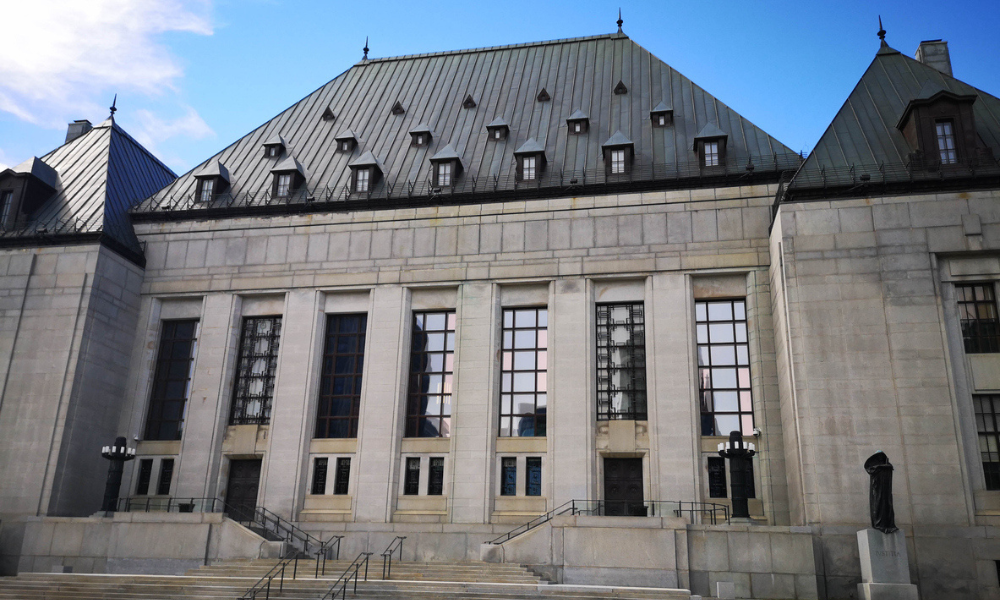But questions still remain about the types of pre-trial motions are covered under the bans

In handing down its decision in La Presse inc. v. Quebec, 2023 SCC 22, the Supreme Court of Canada wanted to clarify how pre-trial publication bans work when a jury isn’t present, but some lawyers say it didn’t quite achieve that goal.
“We’re still in a bit of a Never-Neverland, unfortunately, and that really comes down to, not necessarily the Supreme Court in my view, [but] to the drafting by Parliament. What would have been helpful if they had set out in s. 645 what kinds of motions are covered. And then there’d be certainty,” says Doug Richardson, a media lawyer and partner at ORP Law.
La Presse covers two cases from two jurisdictions. The namesake case originates in Quebec, where Frédérick Silva, who has been described in the media as a “hitman,” was charged with four counts of murder and one count of attempted murder (the shooting of purported Montreal Mafia leader Salvatore Scoppa). In BC, Aydin Coban was charged with several offences relating to child pornography, extortion, child luring, and harassment in the case of Amanda Todd, who died by suicide in 2012.
As the court explained, “In both cases, numerous matters were dealt with before the empanelment of the jury. In Silva’s case, these included a Garofoli application and an application for a stay of proceedings for abuse of process. In Mr. Coban’s case, these included a constitutional challenge to another publication ban under s. 486.4(3) of the Criminal Code. Certain media outlets (the appellants before this Court) applied for orders or declarations that would allow the publication of information from the hearings on those matters. The judges in both cases dismissed the media applications, concluding that s. 648(1) applies before the empanelment of the jury. Information from the hearings could not be published until the juries retired for deliberations or were dismissed.”
The meaning and application of s. 645(5), which “confers upon trial judges the jurisdiction to deal with certain matters before the empanelment of the jury,” was also under consideration in the case.
In delivering the ruling, Chief Justice Richard Wagner held that the appeals should be dismissed.
In coming to that conclusion, he looked back on the intention of Parliament when it drafted the acts that govern how trials are conducted and how publication bans are affected and managed. These include the Criminal Law Amendment Act, 1972, S.C. 1972, which introduced s. 648 and the Fair and Efficient Criminal Trials Act, S.C. 2011 in 2011, which created the role of the case management judge. Both acts focused on making sure court proceedings were fair but also efficient.
“Parliament in 1972 intended to protect another interest falling within the right to a fair trial, namely, the interest of both the accused and society in the efficiency of our system of trial by jury. Parliament made information which would otherwise have been covered by discretionary publication bans subject to an automatic publication ban and, in so doing, demonstrated a clear concern for speedy trials and the proper expenditure of judicial resources,” wrote the Chief Justice.
He also took a very narrow view of how and how much legislative language can be interpreted.
“The words of an Act are to be read in their entire context and in their grammatical and ordinary sense harmoniously with the scheme of the Act, the object of the Act, and the intention of Parliament. The plain meaning of the text is not in itself determinative and must be tested against the other indicators of legislative meaning – context, purpose, and relevant legal norms. A provision is only ambiguous if its words can reasonably be interpreted in more than one way after due consideration of the context in which they appear and of the purpose of the provision. Proposed but abandoned amendments are of no assistance in identifying the meaning of legislation.”
Criminal defence lawyer Trevor Martin of Martland & Saulnier, who appeared on behalf of Coban, indicates that line of thinking revealed the court’s approach to the publication ban issue applying before the jury being empanelled.
“This ruling is about what I’ll call the temporal scope of the publication ban in 648(1) of the Criminal Code… The court decided that issue after a statutory interpretation analysis under the modern approach to statutory interpretation—so it’s a criminal case, but it’s [really] a statutory interpretation case,” says Martin. “I think there’s some useful language in here on statutory interpretation about not only is the text itself not determinative, but it doesn’t have a pre-eminent position in relation to context and purpose. You have to consider all three, and after considering all three, in relation to the statute, the court says yes, it does apply to parts of the trial before the jury is empanelled.”
While this decision looks at two specific cases, the context behind it is more than 20 years of controversies surrounding the interpretation of s. 648, explains Marc-André Nadon, a partner at PFD Lawyers, who acted on behalf of La Presse. He notes that Alberta, for example, has only interpreted this section as applying after jury empanelments since 2000.
In BC, however, “the prevailing interpretation has been the same as what the Supreme Court just found, which is that it applies before jury selection,” explains Martin.
Despite not being the decision he wanted, Nadon can see value in having the ruling. “I think it’s a very positive decision in that sense specifically as no Canadian or professional who has to deal with the criminal justice system has an interest in having a controversy around the application of such an important section.”
As much clarity as this decision offers that subs. 648(1) applies, there is still ambiguity in what 648(1) covers.
“What we are dealing with now is the fact that there will be debate about whether a certain type of motion should not be captured by the purview of ss. 648 and 645… That is the only debate left on the table,” says Nadon.
Richardson explains, “The court can hear any pre-trial motion—and these are the words [in the judgement]—that would ‘ordinarily or necessarily be dealt with in the absence of the jury. What isn’t clear is what motions are normally dealt with in the absence of a jury. There are some that are obvious, such as the admission of evidence—take the situation where you had a confession often those will be challenged because they weren’t voluntary, or maybe the police are alleged to have violated somebody’s rights…, but there’s a whole series of other motions... and it’s not clear whether those are motions that are ordinarily or necessarily brought once the jury has been selected.”
To get around that problem, Chief Justice Wagner suggested that presiding judges should proclaim that specific pre-trial motions are covered under subs. 645(5). “That’s basically best practice, just so that everyone’s aware and on the same page, but it’s not actually necessary for them to do that,” says Martin.
This could pose a problem for reporters who are unsure of whether the particular motions being discussed are ones that would ordinarily and necessarily be dealt with in the absence of a jury.
“From a pragmatic perspective, if you were in the courtroom covering [a pre-trial motion], as a journalist, you’d be wise to stand up at that point and ask the court, ‘Can you please clarify whether this is a 645 motion or not?’” says Richardson. But he notes that reporters aren’t in the courts in many situations. They must rely on decisions published in CanLII, where that clarification won’t necessarily be made or recorded. Reporters will have to attempt to obtain answers from the court—answers which aren’t always available—as to whether a publication ban exists. This is a process that will likely slow down the efficiency of the reporting process, even as the decision focuses on the efficiency of the court system.
“What would have been helpful was if the Supreme Court had fixed the Crown with a duty to seek direction from the judge hearing the pretrial motion to advise is this a s. 645 motion. And the answer to that would give certainty to the media in terms of reporting. If the answer is yes, we know there’s a publication ban. If the answer is no, we can publish it,” says Richardson.
He points out that the punishment for breaching a publication ban is severe. It is a Criminal Code offence, and it isn’t something reporters take lightly.
“It’s the pet peeve I have that journalists, who are just trying to do their jobs, are dealing with an imperfectly worded section and difficult jurisprudence. Nobody wants to breach a publications ban.”










